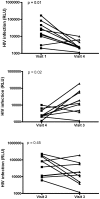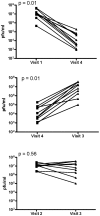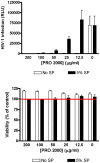Postcoital bioavailability and antiviral activity of 0.5% PRO 2000 gel: implications for future microbicide clinical trials
- PMID: 20107502
- PMCID: PMC2809740
- DOI: 10.1371/journal.pone.0008781
Postcoital bioavailability and antiviral activity of 0.5% PRO 2000 gel: implications for future microbicide clinical trials
Abstract
Background: The pharmacokinetics and pharmacodynamics of vaginal microbicides are typically assessed among sexually abstinent women. However, the physical act of sex may modulate gel distribution, and preclinical studies demonstrate seminal plasma interferes with the antiviral activity of several microbicides. This study compared the biological activity and concentration of PRO 2000 in cervicovaginal lavage (CVL) collected in the absence or following coitus.
Methods: CVL samples were collected from ten heterosexual couples at baseline, after sex, after a single dose of 0.5% PRO 2000 gel and sex, and after gel application without sex. The impact of CVL on HIV-1 infection of TZM-bl cells and HSV-2 infection of CaSki cells was monitored by luciferase and plaque assay, respectively. PRO 2000 concentrations were measured by fluorescence.
Results: CVL collected after PRO 2000 application significantly inhibited HIV-1 and HSV-2 (p = 0.01). However, the antiviral activity was reduced following sex and no significant protective effect was observed in postcoital CVL obtained in the presence compared to the absence of PRO 2000 for HIV (p = 0.45) or HSV-2 (p = 0.56). Less PRO 2000 was recovered in postcoital CVL, which, in conjunction with interference by seminal plasma, may have contributed to lower antiviral activity.
Conclusions: Postcoital responses to PRO 2000 differ from precoital measures and the results obtained may provide insights into the clinical trial findings in which there was no significant protection against HIV-1 or HSV-2. Postcoital studies should be incorporated into clinical studies before embarking on large-scale efficacy trials.
Conflict of interest statement
Figures





Similar articles
-
UC781 microbicide gel retains anti-HIV activity in cervicovaginal lavage fluids collected following twice-daily vaginal application.Antimicrob Agents Chemother. 2012 Jul;56(7):3592-6. doi: 10.1128/AAC.00452-12. Epub 2012 Apr 16. Antimicrob Agents Chemother. 2012. PMID: 22508307 Free PMC article. Clinical Trial.
-
PRO 2000 gel inhibits HIV and herpes simplex virus infection following vaginal application: a double-blind placebo-controlled trial.J Infect Dis. 2006 Jan 1;193(1):27-35. doi: 10.1086/498533. Epub 2005 Nov 17. J Infect Dis. 2006. PMID: 16323128 Clinical Trial.
-
SPL7013 Gel (VivaGel®) retains potent HIV-1 and HSV-2 inhibitory activity following vaginal administration in humans.PLoS One. 2011;6(9):e24095. doi: 10.1371/journal.pone.0024095. Epub 2011 Sep 15. PLoS One. 2011. PMID: 21935377 Free PMC article. Clinical Trial.
-
Clinical development of microbicides for the prevention of HIV infection.Curr Pharm Des. 2004;10(3):315-36. doi: 10.2174/1381612043386374. Curr Pharm Des. 2004. PMID: 14754390 Review.
-
Mechanistic Studies of Viral Entry: An Overview of Dendrimer-Based Microbicides As Entry Inhibitors Against Both HIV and HSV-2 Overlapped Infections.Med Res Rev. 2017 Jan;37(1):149-179. doi: 10.1002/med.21405. Epub 2016 Aug 12. Med Res Rev. 2017. PMID: 27518199 Review.
Cited by
-
UC781 microbicide gel retains anti-HIV activity in cervicovaginal lavage fluids collected following twice-daily vaginal application.Antimicrob Agents Chemother. 2012 Jul;56(7):3592-6. doi: 10.1128/AAC.00452-12. Epub 2012 Apr 16. Antimicrob Agents Chemother. 2012. PMID: 22508307 Free PMC article. Clinical Trial.
-
Griffithsin protects mice from genital herpes by preventing cell-to-cell spread.J Virol. 2013 Jun;87(11):6257-69. doi: 10.1128/JVI.00012-13. Epub 2013 Mar 27. J Virol. 2013. PMID: 23536670 Free PMC article.
-
Bridging the gap between preclinical and clinical microbicide trials: blind evaluation of candidate gels in murine models of efficacy and safety.PLoS One. 2011;6(11):e27675. doi: 10.1371/journal.pone.0027675. Epub 2011 Nov 11. PLoS One. 2011. PMID: 22096611 Free PMC article.
-
Evaluation of PD 404,182 as an anti-HIV and anti-herpes simplex virus microbicide.Antimicrob Agents Chemother. 2014;58(2):687-97. doi: 10.1128/AAC.02000-13. Epub 2013 Nov 11. Antimicrob Agents Chemother. 2014. PMID: 24217696 Free PMC article.
-
Clinical parameters essential to methodology and interpretation of mucosal responses.Am J Reprod Immunol. 2011 Mar;65(3):352-60. doi: 10.1111/j.1600-0897.2010.00947.x. Epub 2011 Jan 12. Am J Reprod Immunol. 2011. PMID: 21223419 Free PMC article. Review.
References
-
- Karim SA, Coletti A, Richardson B, Ramjee G, Hoffman I, et al. Safety and Effectiveness of Vaginal Microbicides BufferGel and 0.5% PRO 2000/5 Gel for the Prevention of HIV Infection in Women: Results of the HPTN 035 Trial 16th Conference on Retroviruses and Opportunistic Infections. 2009 Montreal, Canada.
-
- Microbicide Development Programme. 2009. HIV ‘prevention’ gel PRO 2000 proven ineffective. Available: http://www.mdp.mrc.ac.uk/. Accessed 2009 Dec 14.
-
- Van Damme L, Govinden R, Mirembe FM, Guedou F, Solomon S, et al. Lack of effectiveness of cellulose sulfate gel for the prevention of vaginal HIV transmission. N Engl J Med. 2008;359:463–472. - PubMed
-
- Van Damme L, Ramjee G, Alary M, Vuylsteke B, Chandeying V, et al. Effectiveness of COL-1492, a nonoxynol-9 vaginal gel, on HIV-1 transmission in female sex workers: a randomised controlled trial. Lancet. 2002;360:971–977. - PubMed
Publication types
MeSH terms
Substances
Grants and funding
LinkOut - more resources
Full Text Sources
Medical

